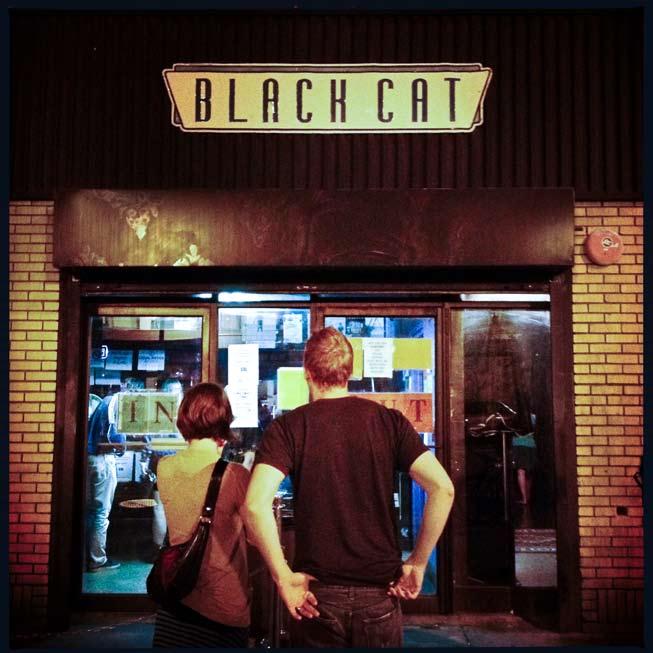ARTS
The Last Show
Darrow Montgomery/File
A writer reflects on the last concert he saw before coronavirus shut down live music.
Black Cat on 14th Street NW By Richard Barry Contributing Writer March 9th, Black Cat, Destroyer. I wish I had a ticket stub. The cascading cancelations, postponements, and reschedulings of the COVID-19 era have quieted the music world, and the silence is off-putting. With arenas, theaters, and clubs shuttered under health mandates, and live music hubs like Los Angeles and New York City considering putting off concerts until 2021, the next in-the-flesh note sounds very far away. Lamenting the loss of discretionary entertainment seems low priority at the moment, but the inability of fans to gather and hear a favorite artist underscores the absence of simple pleasures and the drabness of socially distanced living. Similar to food service’s takeout pivot, the music industry has shifted to home distribution with artists streaming performances. 16 july 17, 2020 washingtoncitypaper.com
But like some menu items, the quality of live music suffers when not consumed immediately and in-person. Experiencing an artist online remains a good option, but when it’s the only option, the texture and enjoyment diminish in the delivery and a previously crisp and nourishing act can wind up with the appeal of soggy fries. Craving a concert firsthand, I have turned instead to the cellphone archive. Videos of questionable quality, previously gathering dust in the photo scroll, have now reached live show status under pandemic conditions. Blurry vignettes of Destroyer at D.C.’s Black Cat, my last in-reallife concert before in-real-life ended, play like found footage of a bygone era. Dan Bejar, tall and louche, hunches over the microphone, creakily reciting the fantastic tone poems of his lyrical spell book. His gray-flecked beard and black mass of wiry hair give him a dark, mystic quality like Alejandro Jodorowsky in El Topo. He
seems like an end-times guy. Not necessarily a prepper or panicbuyer, but a weary, sardonic prophet of doom. In my shaky bootleg of “Tinseltown Swimming in Blood,” the standout number from Destroyer’s 2017 album ken, curving, low bass lines and tumbling percussion backtrack Bejar’s apocalyptic musings with gallows humor to match. Here he envisions “towers coming up for air” and “dead flowers on the skyline,” then takes a break from the modern-day Noah’s ark imagery to ask, “Hey, how was the wine, baby?” As the old political electability saying goes, Bejar is the musician you most want to have a beer (or two) with, especially when it’s all hitting the fan. I paid cash at the door for Destroyer, receiving a red hand stamp instead of a ticket. “Crimson Tide,” the show opener and opening track from this year’s Destroyer release Have We Met, contains an eerily prescient line with Bejar comparing himself to “an ocean stuck inside hospital corridors.” At that moment, the Seattle area, a few hours south of Bejar’s hometown of Vancouver, marked the U.S. coronavirus epicenter with 22 deaths. Although parsing future events from lyrics makes for a tempting quarantine pastime, reading such real-life messages into Bejar’s tea leaves does a disservice to his evocative, imprecise spools of language. While undeniably vatic, Bejar’s prophecy hits the ear as less date-specific, manic street-preacher style and more vague mythos, giving voice not to what will happen, but what could be. And as far as what could happen, no one at Black Cat that night had any idea. Near capacity, the audience distributed itself densely across the venue’s black and white checkered floor squares. Unconcerned by the close proximity, the crowd nodded to the music in vibing approval, not worrying about buying or wearing masks for another several weeks. At the back of the concert hall, I watched the show from the raised vantage of the Red Room Bar. An over-served gentleman in a Hawaiian shirt shoved on a closed elevator door, unsuccessfully seeking the restroom. When concerts start again, what will they look like? In spring, an outdoor venue in Denmark hosted a drive-in show with concertgoers tuning in to an FM radio station. On a recent Live Nation earnings call, Michael Rapino, president and CEO of the global ticketing service, detailed concert reopening scenarios that included, in addition to drive-ins, reduced crowds and bigger artists playing smaller venues. But by nature, concerts stand in direct contrast to the isolations of a lockdown: unsanitized crowd surfing, high-fives from strangers, mosh pit collisions, and all of the physical energy that a song inspires bubbling over, joyously uncontained and definitely not 6 feet apart. The connecting thrill of live music creates a fan base fellowship, almost as essential as the music itself and just as missed. When live music makes its comeback, I hope its mojo does as well, transcending space-making precautions, however necessary they may be. Near the show’s end, Bejar and his band left the stage, and the audience cheered for an encore. More than four months later, with the whole music touring industry having exited stage left, it seems as though an interminable break has settled in between sets. As states reopen in a disjointed, haphazard fashion, music venues do not number among the early phase vanguards, leaving fans waiting and artists stuck waiting in the wings. When Destroyer returned, they closed the show with the triumphant, scale-soaring, nine-minute epic “Rubies.” In what now seems like an early act of social distance protest—and probably a Destroyer first—the guy in the Hawaiian shirt and a partner grinded away on each other like mortar and pestle. I wish I had a video. Four days later, complying with a city health order, Black Cat shut its doors. Destroyer played their last uncanceled tour date in Nashville. And by then, the red stamp on the back of my hand had worn off.








